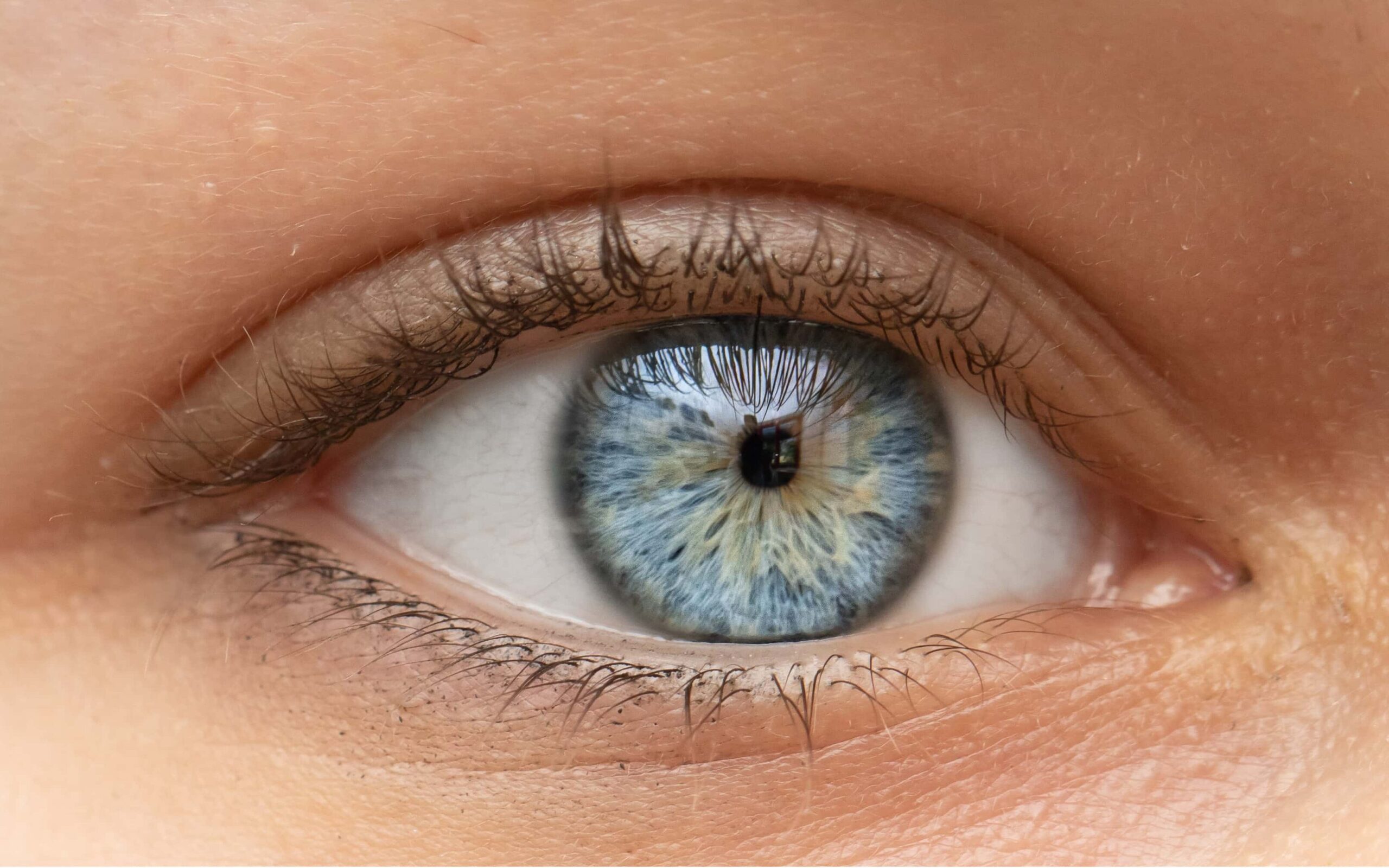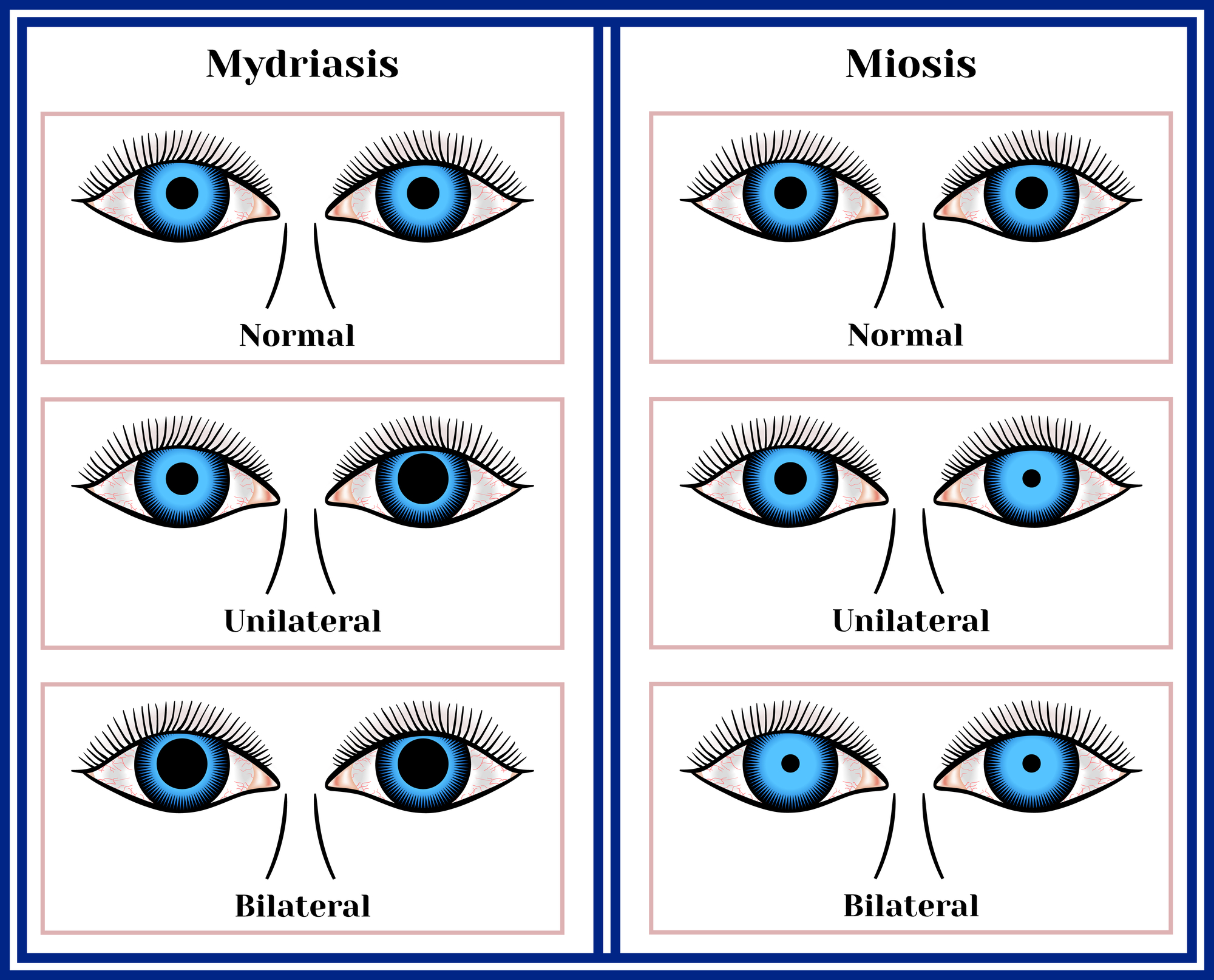Updated on October 9, 2024
Miosis Causes & Treatments


Vision Center is funded by our readers. We may earn commissions if you purchase something via one of our links.
What is Miosis?
Miosis refers to the shrinking of the pupils. For reference, the pupil is the circular dark hole at the center of the eye that allows light in. Pupils respond to light by dilating (expanding) or constricting (contracting) with the help of sphincter and dilator muscles.

Adult pupils measure about 2 to 4 millimeters (mm) in diameter in bright light and 4 to 8 mm in dim light.1 These changes in pupil size regulate the amount of light entering the eye, which is essential for vision in various lighting conditions.
If your pupil is abnormally small (less than 2mm) in diameter and unresponsive to light, it’s called a pinpoint pupil. This condition is also referred to as miosis or myosis. Miosis can affect one (unilateral) or both eyes (bilateral).
Miosis is not a disease but may signal an underlying problem.
What Causes Miosis?
Miosis is normal in bright lights as your pupil size adjusts to regulate the amount of light entering the eye. Pupil contractions are made possible by the iris sphincter pupillae, which are controlled by nerves in the brain. Any damage to these nerves or adjacent parts can cause abnormal pupil constriction.
Below are common causes of miosis:
Underlying Diseases and Conditions
Several diseases and health conditions can be associated with miotic pupils. They include:
- Cluster headaches. A series of short but excruciating headaches occuring in weekly or monthly cycles
- Horner’s syndrome. Caused by a disrupted nerve pathway due to stroke, tumor, or spinal cord injury
- Intracranial hemorrhage and brain stem stroke
- Anterior uveitis/iridocyclitis (Iris inflammation)
- Lyme disease. Tick-transmitted bacterial disease
- Neurosyphilis. When untreated, syphilis spreads to the brain or spinal cord
- Multiple sclerosis (MS). An autoimmune disorder affecting the nervous system
- Brain tumor
- Aphakia. Loss of the natural eye lens
Aging
As you age, the iris dilator muscles responsible for pupil expansion weaken, resulting in smaller pupils (senile miosis). This causes poor night vision. It’s the reason why people 60 years or older require three times more light for comfortable reading compared to those in their 20s.5
Smoking Cigarettes and Vaping
According to studies investigating pupil sizes in smokers and non-smokers, nicotine, the addictive ingredient in cigarettes, can cause pupil constriction.6
In addition, prolonged use of tobacco products, including liquid vapes, can cause reduced retinal activity and poor eyesight.
Traumatic Head Injury
The first step in assessing any head injury case is an examination of pupil responsiveness. Trauma to the head can sometimes cause pinpoint pupils. In this case, constricted pupils may indicate inflammation or bleeding.
Pain medications used to treat such injuries can also cause miotic pupils.
Chemical Exposure
Exposure to chemicals such as organophosphates can cause pupil constriction. Organophosphates are used in manufacturing insecticides, medications, and nerve agents.7 Prolonged exposure to such chemicals can be life-threatening.
Drug Reaction
Certain drugs and medications cause your pupils to appear smaller. These include opioid pain medications such as morphine, heroin (derived from morphine), hydrocodone, and fentanyl.
Other drugs include:
- Pilocarpine eye drops, which help manage glaucoma
- Medications used to treat high blood pressure, such as clonidine
- Cholinergic drugs, such as acetylcholine, carbachol, and methacholine
- Antipsychotics, such as olanzapine, haloperidol, chlorpromazine, and fluphenazine
- Anti-anxiety medications, such as diazepam (Valium)
- Antihistamines, such as diphenhydramine (benadryl)
Genetics
Parents can pass down the gene for pinpoint pupils to their children. As a result, some people are born with weak or undeveloped pupil dilator muscles. This condition is referred to as congenital miosis or microcoria.8
Microcoria can affect one or both eyes, and may be associated with myopia (nearsightedness) or hyperopia (farsightedness).
Surgery
Maintaining mydriasis (dilated eyes) is important during surgical procedures. However, some people, especially diabetics, have a high risk of intraoperative miosis.9
Miosis Symptoms
Shrinking of the pupils is the main symptom of miosis. However, since miosis may result from certain diseases and conditions, accompanying symptoms may vary.
In the case of cluster headaches, miosis may occur alongside:
- Drooping eyelid
- Eye redness
- Tearing
- Runny nose
- Sensitivity to light and sound
- Confusion
- Mood change
- Aggressiveness
In the case of organophosphate exposure, miosis may occur alongside:
- Increased saliva and tear production
- Sweating
- Nausea and vomiting
- Confusion
- Muscle tremors
In the case of intracranial hemorrhage and brain stem stroke, miosis may occur alongside:
- Dizziness
- Vertigo (a feeling of movement/spinning)
- Weakness on both sides of the body
- Occasional jerking or shaking resembling a seizure
- Slurred speech
- Sudden loss of consciousness
In the case of Lyme disease, miosis may occur alongside:
- Fever
- Headache
- Fatigue
- A distinct skin rash (erythema migrans)
In the case of neurosyphilis, miosis may occur alongside:10
- Abnormal walking
- Confusion
- Numbness on the toes and feet
- Headaches
- Seizures and stiff necks
- Weakness and tremors
- Incontinence (loss of bladder control)
In the case of a drug reaction, miosis may occur alongside:
- Shallow breathing
- Confusion
- Difficulty concentrating
- Loss of consciousness
How is Miosis Diagnosed?
Your doctor will use a penlight in a dimly lit room to examine your pupils’ response to light. Common tests used to examine the pupil include:
- Light response test. Assesses the reflexes that cause the pupil to change size based on light intensity
- The swinging flashlight. A pupil test that compares both pupils’ responses to light and determines if only one or both eyes are affected
- Near response test. Measures pupil response based on object distance to rule out certain conditions
Your doctor will also measure your pupil size. You’ll be diagnosed with miosis if it’s less than 2 mm. The test results will help your doctor identify the root cause of your miosis.
How is Miosis Treated?
Miosis signals an underlying condition or disease. Below are common treatments for health issues associated with miotic eyes:
- Prescription drugs. A substitute drug or medication that does not constrict pupils
- Organophosphate poisoning. Treatment with anti-poison drugs such as pralidoxime (2-PAM), atropine, and diazepam
- Opioid drug overdose. Emergency treatment with naloxone, an overdose-reversing drug
- Inflammation due to injury or chronic disease. Treatment with dilating eye drops such as atropine, phenylephrine, or homatropine
- Genetic miosis. Prescription eyeglasses or contact lenses to address vision problems
- Intraoperative miosis. Treatment with surgical irrigation fluid, Omidria (Omeros), and anti-inflammatory drugs (NSAIDs)
Prevention
You can prevent abnormal miosis through:
- Addressing the underlying conditions before they become worse
- Thorough preoperative planning and identification of red flags (to prevent intraoperative miosis)
- Avoiding cigarettes, vapes, and other tobacco products
- Avoiding exposure to organophosphate and other harmful chemicals
- Not abusing drugs such as opioids
- Avoiding activities with a high risk of traumatic head injuries, such as contact sports
Outlook
Miosis is not a disease but a common symptom in various conditions and situations. The condition is rarely painful or life-threatening, but it can sometimes be associated with serious conditions such as strokes, chemical poisoning, or drug overdoses.
Seek immediate medical attention if you notice signs of abnormal pupil constriction.
Miosis vs. Mydriasis
Mydriasis is the opposite of miosis. Someone with mydriasis has abnormally dilated (enlarged) pupils even in bright light. Mydriasis may result from a brain injury, eye injury, cranial nerve damage, or increased oxytocin levels.
Like in miosis, certain opioids and hallucinogenic drugs can cause abnormal pupil dilation (mydriasis).2

In addition to dilated pupils, mydriasis may occur alongside:
- Headaches
- Eye irritation
- Dizziness
- Trouble sleeping
- Difficulty moving the eyes and drooping eyelids (indicates third nerve palsy)
Summary
Miosis refers to the shrinking of the pupils. While not a disease, it may signal an underlying condition or disease. Common causes of miosis include drug reactions, organophosphate poisoning, head injury, smoking, and aging.
Miosis may also be accompanied by other symptoms depending on the underlying cause. Diagnosis involves pupil examination, and treatment is recommended based on the underlying cause.
Avoiding some habits such as cigarette smoking and opioid drug use may decrease the chance of developing miotic eyes.
In this article
11 sources cited
Updated on October 9, 2024
Updated on October 9, 2024
About Our Contributors
Vincent Ayaga is a medical researcher and seasoned content writer with a bachelor's degree in Medical Microbiology. Specializing in disease investigation, prevention, and control, Vincent is dedicated to raising awareness about visual problems and the latest evidence-based solutions in ophthalmology. He strongly believes in the transformative power of ophthalmic education through research to inform and educate those seeking knowledge in eye health.
Dr. Melody Huang is an optometrist and freelance health writer with a passion for educating people about eye health. With her unique blend of clinical expertise and writing skills, Dr. Huang seeks to guide individuals towards healthier and happier lives. Her interests extend to Eastern medicine and integrative healthcare approaches. Outside of work, she enjoys exploring new skincare products, experimenting with food recipes, and spending time with her adopted cats.

